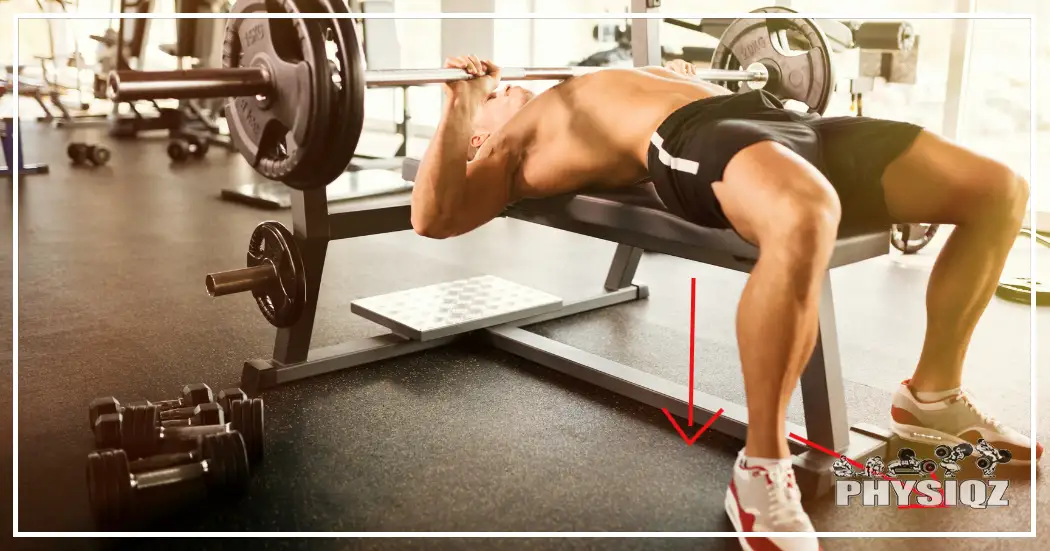
Lifters are often held back from their true potential by making several bench press leg drive mistakes such as improper foot placement, poor positioning on the bench, using the wrong shoes, and more — All of which can all ruin your bench press.1
So rather than treading water, learn where the problem lies and do the fixes below to improve technique and gain a competitive advantage instead.
What Is Leg Drive in the Bench Press & How Does it Help?
A bench press with leg drive is merely using the force of the feet to drive them into the ground to give the body a stable platform to execute a press due to the tension created. To elaborate, the legs push the floor away, which drives power into the hips and shoulder blades and onto the bar.
It is a technique that powerlifters use when attempting a 1 rep maximum weight lift by maximizing the force on the bar but strength-oriented gym goers use it as well.
The leg drive in the bench press helps the lifter maximize on the lift—lifting the most weight by ensuring the upper back is in an optimal position, giving the torso stability and firmness, which translates into maximum strength that can be put into the lift.
The Arched Position
The back has a natural arch, and maintaining that through a bench press is a natural progression that allows the lifter to squeeze the shoulder blades, which insulates them from injury. The shoulders will move forward when the back is flat on the bench. The arch helps by making the lift easier and allowing more load to be placed on the pecs which will aid in hypertrophy.
Lower Pecs Recruitment
Due to the use of leg drive in the bench press, the body is at a mechanical advantage during an arched position. As a result, the nervous system does not need to work as much, making less muscle recruitment necessary to complete the bench. The pronounced consequence is that a lifter becomes better and more efficient due to a mimicked decline bench press.
The arched position allows the bench press to mirror a decline bench press which is a lot easier to do than a flat bench press—this is a common adage among many lifters, and the reason for this is that the lower pecs are recruited more. This leg drive-in bench press affords more loading on the pectoralis major, minimizing the stress on the front delts and making the lift feel easier.2
Upper Traps
The upper back needs to be the primary point contacting the bench— the upper traps should be as high as possible. This will allow the shoulders to be retracted, increasing shoulder stability and performance on the bench press. The technique enables the lifter to drive the upper back into the bench, ensuring no break in this primary contact point.
Is it Okay to Use Leg Drive in the Bench Press? Is it Cheating?
It is not only okay to use the leg drive in the bench press but also recommended to do so, even with hypertrophy work or higher reps. In both cases, the leg drive in the bench press will place the torso into an arch, which is healthier for the shoulders while simultaneously stimulating the lower pecs.3
The use of leg drive in the bench press is not cheating per se, as long as it is done with the correct form. Research has shown that the use of leg drive in the bench press does not correlate to the activation of the upper extremity muscles during a bench press as long as the glutes do not rise from the bench.4 The leg drive is not adding to the muscle activation of the pecs but is only giving a better and stable foundation that improves the press. This is also recognized as a rule in powerlifting, which disqualifies lifters from disengaging the glutes with the bench.
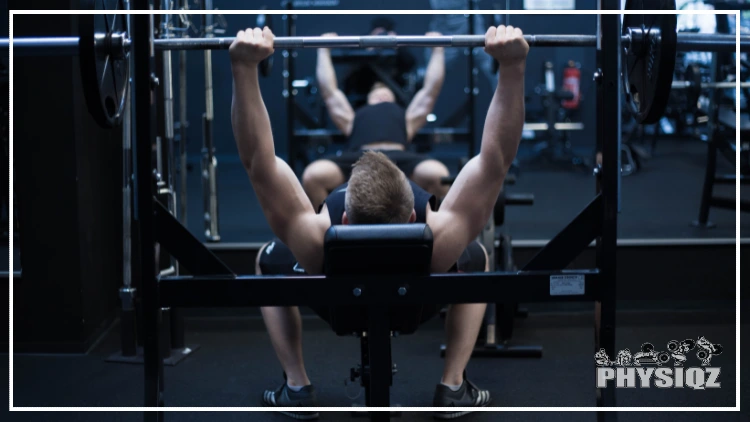
Source: NalaDesignStudio via Canva.com5
Does Leg Drive Help or Increase Bench Press? How Much Does Leg Drive Add to Bench?
Leg drive does help and increases the bench press primarily because it gives the body the ability to create the highest tension by providing a stable platform to drive the weight up. The stability and extra punch translated from the feet places the torso in an effective state on the bench press, allowing the lifter to apply maximum force on the bar.6
In addition, the arch created due to the position shortens the range of motion, allowing someone to lift heavier weights. When the spine is flat on the bench, the shoulders roll forward, resulting in an increased range of motion which translates into more work, thus reducing performance.
With this in mind, studies have shown the leg drive can add anywhere between 5-20% to a lifter’s bench press.
Bench Press Leg Drive: Top 8 Mistakes
When done improperly, the leg drive in the bench press will render it unproductive and is usually attributed to a number of commonly seen mistakes. These errors are counterproductive to the lift and hold a lifter back from their full potential.
#1 Improper Foot Placement for Toes Back & Feet Flat Benching
For lifters who place the toes on the ground, excluding their heels, the most common mistake is that toes are so high that there ceases to be an effective drive. There is too much tension in the quads, and the individual cannot drive the legs properly into the ground.
For those individuals that use the feet flat benching the feet being too close together is a mistake. The lifter in this case is only able to extend back and unable to drive the knees and get tension in the hips crucial to a firm platform.
Generally, keeping the feet flat and driving through the heel rather than toes—specifically its outer part, is better to maximize leg drive. Using the toe back technique could lead to overarching the back but of course, experiment to see what works best.
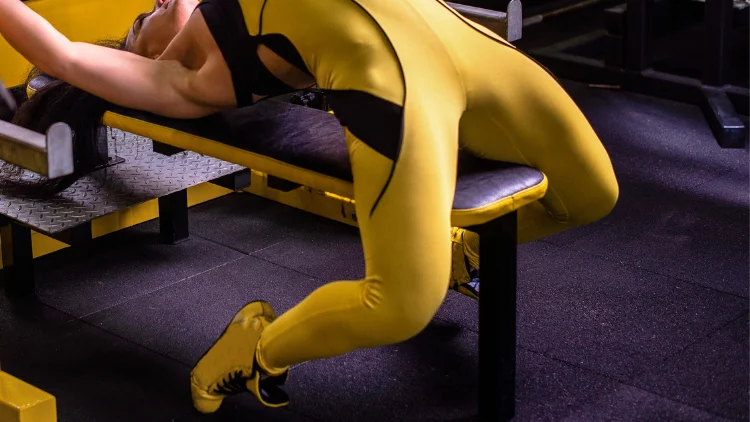
Source: VlaDee via Canva.com7
#2 Not Engaging the Glutes
Lifters tend to engage and recruit the quads at the expense of their glutes and hips, which causes an unstable base. The leg drive should come from the glutes and the hips with the quads being engaged as a side effect. This is because the hips are a primary muscle of engagement in all the big lifts—bench press, deadlifts, and back squats.
Contracting the glutes will transfer tension from the lower body to the upper body, and not doing it renders the arch weaker, leading to less tension in the upper back.
#3 Only Driving Down With the Legs
A common mistake that is common to both new and novice lifters is that they do not correctly push the feet. They only push the feet only away from them when they should be pushing down and away.
#4 Trying to Time Bench Press Leg Drive
This mistake is often seen in the gym. Lifters can be observed timing their leg drives incorrectly. The bar is brought down to the chest, and then during the push back to the starting position, the lifter drives down the feet into the ground, pressing with the assistance of the legs.
The leg drive, in this case, is not being used when the bar is descending back to the chest, which will cause poor lat engagement, the press will be pretty erratic, and the lifter is not in an optimal position. The bar is also pushed further up than is necessary, increasing the range of motion.
Also, it is common to see lifters only engage the leg drive after removing the bar from the rack, compromising on position and expending effort that would be used to regain proper position.
#5 Bridging Up & Lifting of Glutes
Lifting the butt or bridging up is a common mistake among many lifters and happens when someone does squeeze the glutes, which is the correct thing to do but ends up pushing their feet into the floor while raising their hips up.
This action mirrors a glute bridge and should not.
This process also raises the glutes off the bench, which causes a reasonably unstable platform paving the way for potential injuries.
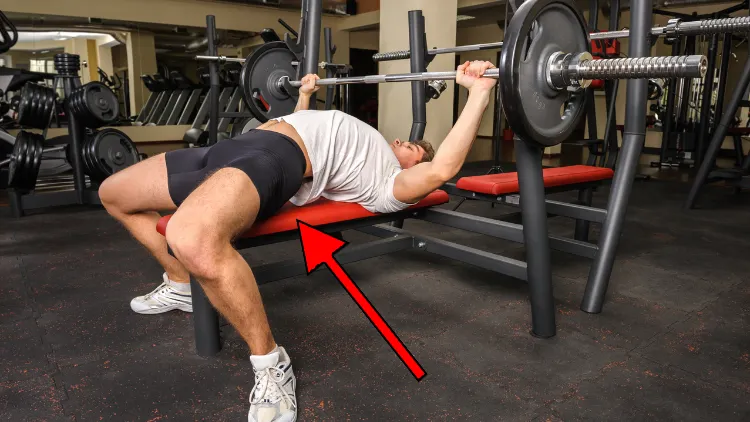
Source: starush via Canva.com8
#6 Disengaging the Leg Drive After Unracking
This is often seen in the gym. Individuals tend to engage the leg drive when they initiate the press and then disengage while adjusting the feet between repetitions. This cycle of engaging and disengaging will cause tension loss, compromising the optimal position.
#7 Using the Wrong Shoes or Footwear
Many lifters have the misconception since the bench press is an upper body workout, they will not follow up with the ideal shoes as they would in a squat. They will tend to use shoes that cannot effectively transfer force from the feet up to the bar.
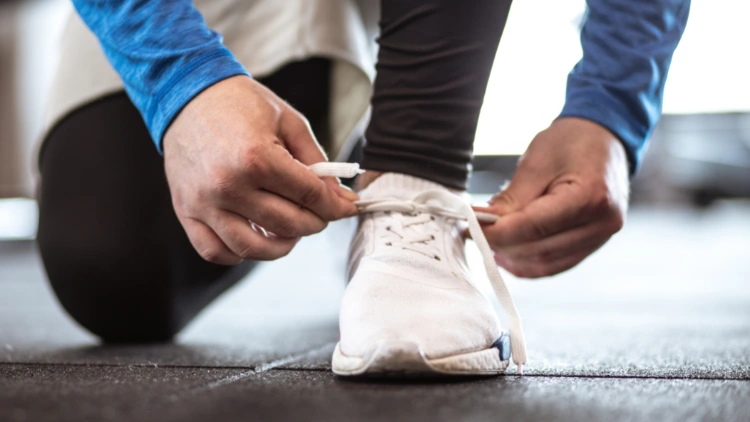
Source: Mladen Zivkovic via Canva.com9
Here are a few more tips in the form of a video for those visual learners.
#8 Benching on Benches of the Wrong Height
Using the wrong bench is a common mistake due to an ineffective base since the height has to be in a range to allow lifters to employ leg drive during the bench press.
How To Use Leg Drive When Bench Pressing
It is imperative that lifters address key components of the leg drive to ensure maximum benefits are extracted from the technique and performed safely. Doing this instead will ensure the correct form, and lifters should pay attention to their arches, glutes, bench type, shoes, and foot placement.
Use the Arching Technique Properly
The arch will reduce the range of motion in a bench press, allowing the lifter to haul more weight while doing less work.10 Correct leg drive in the bench press will support the arch, and a properly arched set up with upper traps tucked into the bench will translate into a better leg drive on the bench press.
Correct Engagement of the Glutes
It is critical to have the glutes to be under constant tension during the lower body engagement in the bench press to allow tension to be transmitted from the feet through the hips into the torso and onto the bar.
Do this instead and contract them throughout the lift. Someone can imagine that they are trying to crack a nut between their butt cheeks to ensure proper tension.
Be Sure the Glutes Are Not Raising
Glutes must remain on the bench, although they are not the primary contact— the feet and the upper back are. Raising them is an all too regular occurrence that places unnecessary stress on the lower back.
Keeping the glutes tucked into the bench can be accomplished by pushing the feet away from the ground and increasing the width between the legs.
Squeeze the Bench With Your Legs
This technique is to be incorporated by lifters employing a narrow stance as it is impossible to do when the legs are wide apart. A lifter should squeeze the bench, which will cause the adductors (the muscles in the central part of the thigh), hamstrings, and glutes to be activated, which results in a much more powerful leg drive for the bench press. This will also prevent the glutes from rising off the bench.
Keep Constant Engagement of the Leg Drive
The lifter should never shuffle their feet around during the bench press once they are set up for the lift. There should be constant tension from the leg drive, and this should be maintained at all times to avoid placing the body in a non-optimal position.
Don’t Try Timing the Leg Drive
Leg drive should be initiated even before the barbell leaves the rack. This will enable a stable torso and arch. Lifters often engage the leg drive when they unrack the bar, and this should not be the case as it compromises someone’s position.
Place Foot Properly
Lifters that partake in toe back benching will need to use the balls of their feet rather than go too far back, rendering the leg drive in bench press ineffective. Individuals who use a flat foot will need to ensure that they only drive through the heels. The heels should be lower as much as possible to create sufficient tension—with the main point of contact with the floor being at the outer part of the heel.
The feet should also not be placed too far back or forward, making it difficult to exert maximum force on the leg drive. Practicing this would help get the best placement for an individual due to diverging anatomies—lifters should experiment with both width and shin angle to achieve what they are comfortable with.
Use the Correct Shoes
Having the right shoe matters if an individual is placing the whole foot on the ground—those using their balls of the feet need not be concerned about footwear.
So do this instead and make use of Olympic lifting shoes. These afford a better range of motion because the feet can be placed back without needing to raise the heels off the floor.
Correct the Direction of the Leg Drive
The leg drive should be done correctly, pushing the feet both towards the floor and away from the torso—similar to an individual sitting on an office chair with wheels. The glutes will remain firmly placed on the bench by pushing away from the ground. This can be done with practice and finding the correct foot position that will result in the torso being properly secured to the bench.
Use the Right Bench Type
Using the correct bench would go a long way to ensuring a lifter can execute the technique correctly, and they should do their best to use a bench that is 16.5-17.5 inches between its top and the floor. The bench should also have a minimal gap between the pad that supports the back and the seat if it is adjustable. Ideal benches that can be used are Rep FB-5000 and Vulcan prime bench.
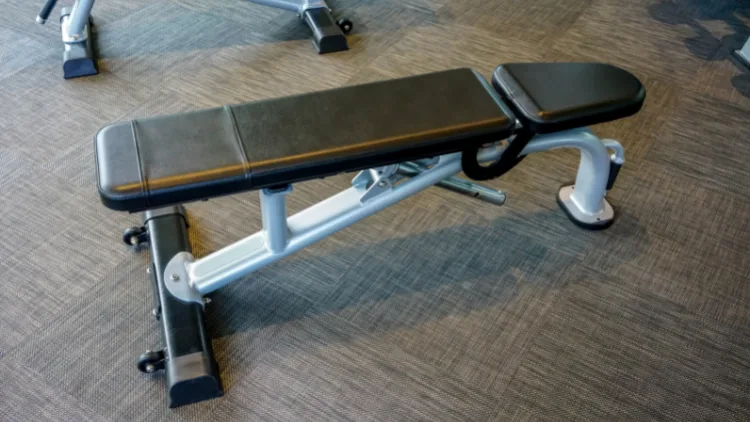
Source: Vudhikul Ocharoen via Canva.com11
Other Tips to Improve Leg Drive on the Flat Bench Press
In addition to using the fixes above, try experimenting with some of these concepts to see what works best for you because no two lifters are the same.
- Increase the intensity of the leg drive when pressing and decrease during the lockout.
- Shoulders should be back and out.
- Flex glutes and not quads.
- Horizontal push back with legs.
- Reach up with the sternum.
- Wider stance for long legs; narrower stance for shorter legs.
- Visualize drive as a leg extension to give the feeling of the quads flexing.
- Heels should be behind the knees which should be driven out.
- Forcing heels to the front of the shoe.
- Drive the toes to the front of the shoe.
- Warm-ups and flexibility stretch before the press.
- Incorporate hip thrusts and glute bridges into the regimen.
Leg Drive Cues for Bench Pressing
There are several leg drive cues for bench pressing that any lifter should include in their bench press regimen to obtain a good leg drive in the bench press. The most important cue would be the way that the leg drive should be completed.
The lifter should place the feet at an optimal distance whilst squeezing the bench, with heels pressed to the floor—then drive the feet away from the ground as if to spread the floor pushing the upper back into the bench—while contracting the glutes and engaging the hips to provide a driving force into the bar.
The bench press leg drive is a tool most commonly used by elite powerlifters and bodybuilders, but when done correctly, it can result in phenomenal results that completely transform amateur and professional lifters’ bench press as well.
Frequently Asked Questions
Do You Have to Use Leg Drive While on Dumbbell Bench Presses?
You do not have to use leg drive while on dumbbell bench presses. However, they could still be included to improve performance by allowing the lifter to push 5-10% more weight. Not only this, it will allow someone to lift heavier dumbbells which in turn places more stress on the pecs leading to hypertrophy. Since the dumbbell bench press is the cousin of the barbell press, these gains also carry over to the bar.
Can You Bench Press Without Leg Drive? What’s the Bench Press Without Leg Drive Called?
A lifter can certainly bench press without leg drive. However, bench pressing with leg drive will allow the lifter to improve the press’s performance, allowing an easier lift while adding more weight to the exercise. This will have a positive impact on strength and hypertrophy.
There are some cases where lifters opt not to place their legs on the ground; this allows these individuals to place more stress and emphasis on the pecs, triceps, and shoulders—which typically makes the lift more challenging. A bench press of this kind is called a Larsen press. A Larsen press can be included to bring variation to the training regimen.
References
1nd3000. “Bench pressing in a gym.” Canva. Accessed 8 April 2023. <https://www.canva.com/photos/MADFBmmlCSA-bench-pressing-in-a-gym/>
2Medicine, N. L. (2015, March 23). Influence of bench angle on upper extremity muscular activation during bench press exercise. Retrieved 2022, from <https://pubmed.ncbi.nlm.nih.gov/25799093/>
3Health, C. (2022). BENCH PRESS: HOW MUCH ARCH IS TOO MUCH ARCH? Retrieved 2022, from <https://cleanhealth.edu.au/blog/bench-press-how-much-arch-is-too-much-arch/>
4Sciences, I. J. (2019, February 1). Leg-drive Does Not Affect Upper Extremity Muscle Activation during a Bench Press Exercise. Retrieved 2022, from <https://doi.org/10.13189/SAJ.2019.070103>
5NalaDesignStudio. “Bodybuilder Guy in Gym, Bench Press.” Canva. Accessed 8 April 2023. <https://www.canva.com/photos/MAFDPNSdTL4-bodybuilder-guy-in-gym-bench-press/>
6Medicine, N. L. (2015, February 25). Inter-subject variability of muscle synergies during bench press in powerlifters and untrained individuals. Retrieved from <https://pubmed.ncbi.nlm.nih.gov/24372591/>
7VlaDee. “Woman training on bench press.” Canva. Accessed 8 April 2023. <https://www.canva.com/photos/MAEAcAP3CbU-woman-training-on-bench-press/>
8starush. “young man doing bench press workout in gym.” Canva. Accessed 8 April 2023. <https://www.canva.com/photos/MADAGKuRW74-young-man-doing-bench-press-workout-in-gym/>
9Zivkovic, Mladen. “Preparation for exercises.” Canva. Accessed 8 April 2023. <https://www.canva.com/photos/MADerMWD3Lo-preparation-for-exercises-/>
10Association, N. S. (2019). The Bench Press: A Comparison Between Flat-Back and Arched-Back Techniques. Retrieved 2022, from <https://journals.lww.com/nsca-scj/Abstract/2019/10000/The_Bench_Press__A_Comparison_Between_Flat_Back.11.aspx>
11Ocharoen, Vudhikul. “Adjustable gym bench with black leather in public gym ready to use.” Canva. Accessed 8 April 2023. <https://www.canva.com/photos/MADZosJm7WA-adjustable-gym-bench-with-black-leather-in-public-gym-ready-to-use-/>